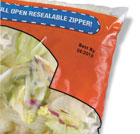
Fresh produce is the subject of an industrywide initiative for traceability, due in part to its perishability and the fact that most of it is consumed raw. (Photo courtesy of Videojet)
Fresh produce is sprouting a fresh approach to traceability.
The Produce Traceability Initiative (PTI) was started in 2008, partially as a reaction to a high-profile spinach contamination case two years before. Coordinated by the United Fresh Produce Association (UFPA) and other industry groups and leaders, the industry-led initiative seeks to specify how to provide information on packages and pallets that will allow product to be traced throughout the supply chain.
The idea is to be able to trace all fresh produce at least one step up and down the supply chain at all times by 2012. (For a brief further explanation of PTI, see “Taking the initiative for produce safety”.) As it is now constituted, the PTI concentrates on case-level coding, as opposed to coding on individual packages, says Dan Vache, the UFPA’s vice president for supply-chain management.
“What we’re trying to do is incorporate [coding] at the case level so that we can see when it arrives, how long it was there, and when it exited,” Vache says. “If you have item-level [tracking], you can easily trace it back to the supplier, but you miss the interim steps.”
Bars and letters
This coding comprises both bar codes and human-readable information. One complicating factor is the same thing that makes the PTI as a whole so tricky: the multiplicity of points of origin and transit in the fresh produce supply chain.
“Trying to identify fresh produce is probably going to be one of the bigger challenges of the product identification industry to accomplish, because of how it comes to market,” says Lynn Deiro, senior sales manager atHitachi America.“Some of the stuff is picked in the field and put directly into a box and shipped directly to a market. Some is run through processing plants.”
This creates differences in volume and other factors that would affect the choice of coding and marking equipment. Options range from simple peel-and-stick labels hand-applied in the field, to coding and marking systems with the most sophisticated databases and information technology available.
“From a practical point of view, it needs somebody to make an assessment of their packaging process to see what makes sense,” says James Butcher, software unit business manager forVideojet.
One of the most important choices would be which application technology to use. The two most basic choices are print-and-apply and ink jet.
This is, of course, a classic choice for many coding and marking applications. Print-and-apply labels are dependably readable on most any substrate, while ink-jet printing has notably lower operational costs. Fresh produce marking has certain complicating factors, such as temperature and humidity swings between a hot field and cold storage. Accuracy is especially important under the PTI, because bar codes will contain a multiplicity of information that, if misread, could trigger a false recall.
UFPA neutral
Although print-and-apply is more of a sure thing, the UFPA isn’t taking an official position on the question, Vache says.
“My position is if [ink jet coding is] readable and scannable...and you can take some of the cost out, why wouldn’t we do that?” he says. “We shouldn’t shut people out because someone says the data has to go on a label because years ago that was the only method that would work.”
Even though ink-jet coders have lower operational costs than print-and-apply systems, the high-resolution piezoelectric coders needed to print readable codes can still be expensive. Dean Hornsby, director of integrated solutions forMatthews Marking, described a system for a high-volume fruit processing operation that mitigated this expense.
This was a co-op that processed fruit from many nearby growers and wanted to code the cases by grower. Cases were packed on about 20 lines that were merged into one for final coding.
Matthews supplied the co-op with relatively low-cost drop-on-demand ink jet coders, one for each packing lane. These printed a preliminary “trigger code” on the cases as they went by. When the cases merged into one lane, a vision system read the trigger codes and signaled a high-res Matthews IP700 to print a customized, scannable bar code on each case.
Bill Myers, marketing manager forDiagraph, says the PTI is a chance for the produce industry to get its own house in order before the next big outbreak.
“They’ve gotten together and said, ‘OK, let’s regulate this within our own industry versus government having to regulate it for us,’” Myers says. “Because once it gets to that level, things become a lot more stringent.” F&BP
